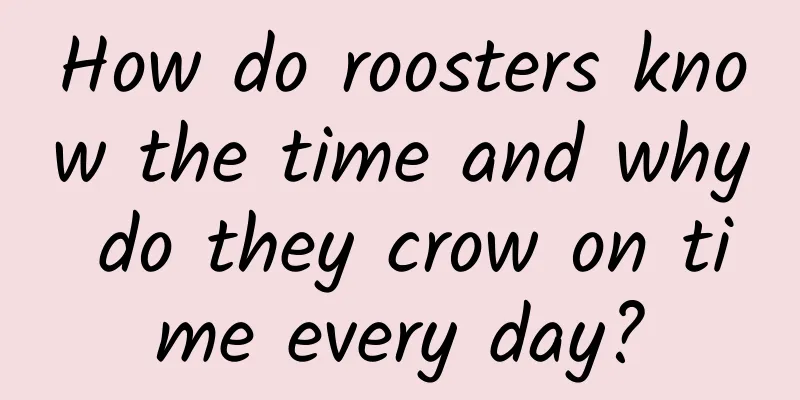How do roosters know the time and why do they crow on time every day?

|
Apart from the barking of dogs and cats, the crowing of a rooster is considered one of the most recognizable animal sounds in the world. No matter where you are from, as long as you hear "cock-a-doodle-doo", you basically know that it is a rooster crowing. In fact, there are many interesting facts about the crowing of roosters, such as their crowing sound can exceed 130 decibels, which is equivalent to the sound made by a jet flying 15 meters away from our ears. In comparison, the current Guinness World Record for the loudest human sound is only 129 decibels, while ordinary people can only make sounds around 100 decibels. Interestingly, they don't have to worry about their ears or vocal cords because of the loud noises they make. The reason for this is, of course, that they have very funny ears and they don't have vocal cords at all. In addition, before the alarm clock was invented, the crowing of the rooster served as an alarm clock for us because it would always crow on time before dawn. This strange, punctual crowing behavior has long been talked about, more than the chicken's anatomy, but it wasn't until 2013 that people truly understood the mystery. How do roosters crow on time? Since many bird behaviors are affected by light levels, until 2013 it was widely believed that rooster crowing was also affected by this, with the dawn sunlight being thought to be a signal that stimulated the roosters to crow. But it turns out that in most cases, when the first rooster starts crowing, the sun has not yet appeared. It usually crows about 2 hours before dawn. In 2013, researchers from Nagoya University in Japan conducted a group observation study on roosters with these questions in mind[1]. They divided the experimental roosters into several groups, with 4 roosters in each group, and conducted two parts of the experiment. In the first part of the experiment, they placed several groups in a dimly lit room. Although the roosters could occasionally crow at any time of day, most of their crowing was still like a clock, reaching a peak frequency every 24 hours or so. This means that the factor that stimulates roosters to crow may not be sunlight (the light in the experimental room remains unchanged), but that they have their own crowing rhythm. This crowing rhythm lasted for 2 weeks and then gradually disappeared. This part of the experiment lasted a total of 4 weeks. In the next two weeks, the frequency of the roosters' crowing at any time of the day decreased and became irregular. This means that although sunlight does not stimulate roosters to crow, it will affect the rooster's crowing rhythm. In the second part of the experiment, the researchers placed several other groups of roosters in a room with alternating cycles of 12 hours of light and 12 hours of darkness. The result was that the roosters' crowing frequency increased before the "dawn" of the 12-hour cycle. This further suggests that an underlying circadian cycle plays a role in rooster crowing. Therefore, the Japanese researchers concluded that the crowing of roosters does not occur under the stimulation of sunlight, but the regular circadian rhythm forms a biological clock in their bodies, which tells them to crow before dawn. Further research showed that before dawn, roosters begin to release large amounts of testosterone (male hormone) in their bodies, which is why they crow. You may also be wondering what is the nature of the biological clock? This is actually the role of the Earth's day and night alternation in biological evolution. It is actually an instinct. Organisms use genetic control to form a natural "timekeeping device" in their bodies to help them survive. This happens to all organisms that can feel the alternation of day and night, including humans. Then there is another question, why do roosters crow before dawn? Wouldn't such a loud crowing give them away and attract predators? Picture: Male red junglefowl. Domestic chickens are domesticated from wild red junglefowl. Why do roosters crow? Before they were domesticated by humans, roosters were common in jungles throughout Southeast Asia, where the dense vegetation provided them with protection but also made it difficult for the roosters to see each other. So the reason roosters crow is because they need to communicate in this way. And because chickens are social animals, they have a very strict social hierarchy, so roosters crow in many different ways. The crowing before dawn is considered a way for roosters to assert their territory, so you'll find that roosters like to go to high places to crow. If there are multiple roosters in a group, the leader will crow first, and then the other roosters will follow in turn. The crowing order reflects their social status. When the health of the first leader is in trouble, the other roosters are the first to challenge by crowing out of turn. In addition, this crowing sound that declares territorial sovereignty is also a warning signal to other chickens, telling nearby roosters and chickens to leave quickly and not to come near, as this is its territory. Chickens have excellent hearing, and they use the sound of their crowing to determine whether to leave or move forward, to challenge, or to crow in order. I think that the crowing of the rooster in this situation is a bit like our quarrel. Quarreling is very meaningful. It can effectively avoid physical conflicts and thus avoid injuries. After all, if one party feels that the other party is stronger, it will not take further action. In addition to crowing at dawn, roosters have several other characteristics when crowing, such as their habit of crowing after mating and after hens lay eggs, and they are also likely to crow when they encounter intruders. Based on the crowing of roosters in different occasions, we can infer the meaning of rooster crowing. In summary, they are telling their peers about their health status, location, and dangerous situations. Of course, yelling is not a good option for survival in the wild, but roosters apparently gain more benefits from their loud crowing than from crowing at the risk of exposing themselves. Finally: Why do hens crow? We mentioned earlier that the reason why roosters crow before dawn is because their bodies suddenly increase testosterone during this period. In fact, most of the time, the crowing of roosters is closely related to the secretion of testosterone, and the higher the level of testosterone secretion, the louder the crowing will be. Many people may know that hens sometimes crow, and there is a special idiom for this - "hens crow at dawn". Due to some historical allusions, the crowing of hens is often considered a bad omen. But in fact, it is quite normal for hens to crow, because hens have a very interesting physiological structure. Hens have two ovaries, but only the left ovary develops as the hen grows and only the left ovary secretes female hormones, while the right ovary is dormant. When the left ovary is damaged for some reason, the hen will be unable to secrete estrogen, and instead testosterone levels will soar, causing the right ovary to open. At this time, the hens will begin to show many male characteristics, including crowing. What do you think about this? Welcome to leave a message in the comment area. Follow CHN Jiuxiang Technology, and through popular science, you will find that there are too many wonderful things in this world. |
<<: Being merciful with your words may harm your child!
Recommend
A guide to avoiding pitfalls when promoting with overseas influencers in 2022!
What are the pitfalls of overseas influencer mark...
Eating seafood and finding pearls at sky-high prices?! Do I still have a chance?
From time to time, we see in the news that people...
What exactly is the Huawei Matebook like?
Huawei is also going to release a notebook. This i...
App promotion is at a bottleneck? 7 ways to solve your problems!
We all know the importance of App marketing . If ...
Yan Jie "Stretching Light Yoga" 14-day fast-acting metabolic slimming yoga tutorial video
Training course content: CCTV's specially inv...
13 ways to market on Children's Day
How to do topic marketing on Children's Day? ...
Bilibili Operations: How to grow from 0 to millions of followers?
With the explosive growth of the video industry, ...
We often hear that “pull out one grey hair and ten will grow back”? Is this true?
According to the "News Hyperlink" of Ch...
When exploring an extraterrestrial planet, does the probe fly in a straight line? Learn more about the Hohmann transfer orbit
In "Elements" written by the ancient Gr...
After Ji Yue falls, who will be the next?
Cars come and go, people come and go. In the tide...
How to get Douyin Blue V certification? Let us teach you how to get Douyin Blue V certification.
Douyin Blue V certification can be said to be a n...
You cannot drink alcohol after taking cefuroxime, so how long after drinking alcohol can you take cefuroxime?
China's Spring Festival happens to be in the ...
The aircraft carrier that made everyone proud became his farewell gift...
China's first generation carrier-based fighte...
The June Douyin course of Shudi Research Institute: Douyin Mini Program 2.0 will definitely explode with routines. How to make hundreds of yuan a day with zero fans and no display window
The June Douyin course of Shudi Research Institut...
How to create an effective brand slogan?
Why do brands and marketing companies pay so much...









